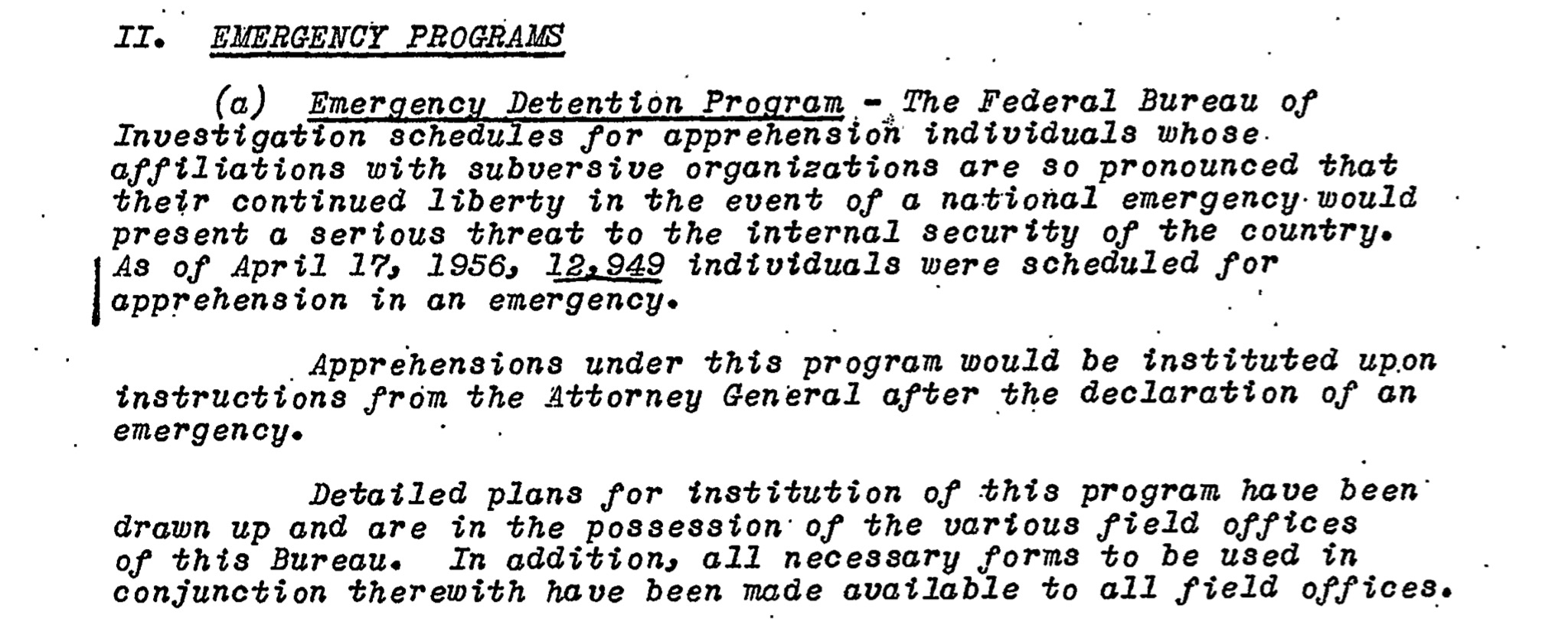Plan C: The Top Secret Cold War Countermeasure Which Would Have Brought the United States Under Martial Law
The FBI made a secret plan in case nuclear war broke out
January 30, 2015International Business Times - The United States government made extreme, top-secret plans for preserving national security in the event of a nuclear attack during the Cold War, according to documents recently released to transparency journalism organization MuckRock.
The FBI created "Plan C" in 1956, the same year the Red Army shut down the Hungarian Revolution, and if activated, Plan C would have put the nation under martial law and allowed for nearly 13,000 people to be detained for having links to "subversive organizations."
The FBI held a briefing with three top officials from every department to distribute papers outlining Plan C, which was later given to FBI field offices. The plan was ordered to be destroyed in July 1957.
Although the plan was never released, MuckRock's memos from closed meetings with high-ranking officials give readers an idea of what could have happened. Plan C would have gone into effect "after a war has begun in which the U.S. is involved or may become involved and prior to an actual attack on the U.S. itself," according to the documents.
Government organizations would decide which of their employees were essential and have them hide out in backup offices. Soviet embassies would be searched for weapons, radios and explosives. Up to 900 Soviet diplomats and couriers would be taken into custody.
In an emergency, the government would also have activated a detention program that would have led to arrests for "individuals whose affiliations with subversive organizations are so pronounced that their continued liberty in the event of national emergency would present a serious threat," according to the documents. The exact number of people who would be affected was set at 12,949.
FBI workers were allowed to tell their families about Plan C in vague terms only but were also encouraged to make preparations.
"The stressing to all employees that it is the employee's moral responsibility to plan for survival and for the care of his family, to see that his family is aware of such planning, and to go into such planning, in detail, with his family," one memo reads.MuckRock has requested about 150 additional pages regarding Plan C under the Freedom of Information Act. The FBI is consulting with other agencies before releasing the documents. Plans A and B did not exist.
Plan C: The top secret Cold War countermeasure which would have brought the United States under martial law
12,949 individuals would immediately be detained as a likely threat to national security for their ties to "subversive organizations."January 26, 2015
MuckRock - Starting on April 19, 1956, the federal government practiced and planned for a near-doomsday scenario known as Plan C. When activated, Plan C would have brought the United States under martial law, rounded up over ten thousand individuals connected to "subversive" organizations, implemented a censorship board, and prepared the country for life after nuclear attack.
There was no Plan A or B.
The first known mention of this strategy was a memo released by the FBI to MuckRock under a Freedom of Information Act request. It is an invitation to the Bureau to attend an afternoon meeting on April 19, 1956, organized by the Office of Defense Mobilization.
Held in the same room as the president's usual press briefings, just across from the White House in the Executive Office Building, this briefing requested the presence of three top officials from every department, except the Department of Justice which was asked to bring four.
It was here that the broad details of Plan C were laid out:
- Officials would designate certain personnel as essential, and develop secretive remote backup offices to be used in the event of an emergency. Each of these sites was to have multiple communications links with the outside world.
- The plan was to go into effect before actual war broke out, but when conflict with the USSR seemed imminent.
- Martial law would be declared, and 12,949 individuals would immediately be detained as likely threats to national security due to their ties to "subversive organizations."
- Soviet diplomats and couriers would be taken into protective custody before being handed over to the State Department. Embassies would entered and searched for nuclear devices.



Details of this program were distributed to each FBI field office. Over the following months and years, Plan C would be adjusted as drills and meetings found holes in the defensive strategy: Communications were more closely held, authority was apparently more dispersed, and certain segments of the government, such as the U.S. Attorneys, had trouble actually delineating who was responsible for what.
Bureau employees were encouraged to prepare their families for the worst, but had to keep secret the more in-depth plans for what the government would do if war did break out. Families were given a phone number and city for where the relocated agency locations would be, but not the exact location.

While the released memos (which were stored in the FBI's secretive Special File Room) trace much of the general outlines of Plan C, the Plan itself was never released. A July 3, 1957, memo ordered the destruction of copies of the Plan, perhaps because they were outdated, superseded, or just too controversial.
And while the FBI released about 30 pages of memos and communications regarding Plan C, there are about 150 more pages that the FBI is still processing, consulting with other departments and agencies (notably, FEMA) regarding their appropriateness for release.

One of the released sections is embedded below, and you can read more on the request page.



No comments:
Post a Comment